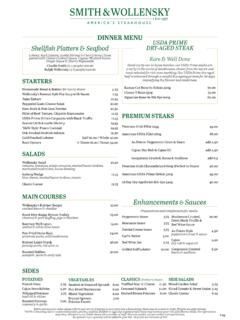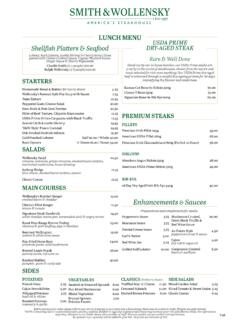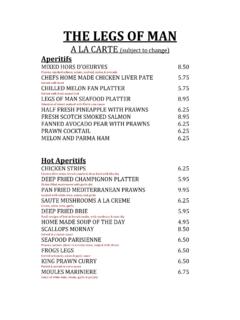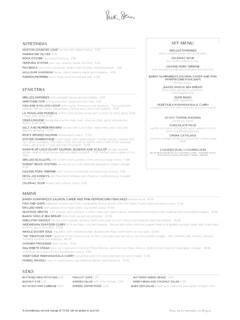Transcription of MACRONUTRIENTS, MICRONUTRIENTS AND WATER
1 UNDERSTANDING NUTRITIONAL STRATEGIES AND THE KEYS TO MACRONUTRIENT BALANCE AMERICAN COUCIL ON EXERCISE All Rights ReservedMACRONUTRIENT, MICRONUTRIENTS , AND WATER 1 MACRONUTRIENT STRUCTURE AND FUNCTION FOOD IS COMPOSED OF SOME COMBINATION OF THREE macronutrients: carbohydrate, protein, and fat. The term macronutrient simply means that the nutrient is needed in large quantities for normal growth and development. Macronutrients are the body s source of calories, or energy to fuel life processes. CARBOHYDRATESC arbohydrates are the body s preferred energy source.
2 Made up of chains of sugar molecules, carbohydrates contain about 4 calories per gram. A monosaccharide is the simplest form of sugar. The three monosaccharides are glucose, fructose, and galactose. Glucose is the predominant sugar in nature and the basic building block of most other carbohydrates. Fructose, or fruit sugar, is the sweetest of the monosaccharides and is found in varying levels in different types of fruits. Galactose joins with glucose to form the disaccharide lactose, the principal sugar found in milk. Other disaccharides include maltose, which is two glucose molecules bound together, and sucrose (table sugar), which is formed by glucose and fructose linked together.
3 An oligosaccharide is a chain of about three to 10 or fewer simple sugars. A long chain of sugar molecules is referred to as a polysaccharide. Glycogen, an animal carbohydrate found in meat products and seafood, and starch, a plant carbohydrate found in grains and vegetables, are the only polysaccharides that humans can fully digest. Both are long chains of glucose and are complex carbohydrates (versus simple carbohydrates, which are short chains of sugar). Carbohydrates consumed in the diet that are not immediately used for energy are stored as glycogen. Glycogen is stored in the liver and muscle cells and can be broken down into single glucose molecules to provide a rapid source of energy.
4 The amount of stored glycogen can be increased fivefold with physical training (Mahan & Escott-Stump, 2000). Carbohydrate loading also increases glycogen stores. Because glycogen contains many WATER molecules, it is large and bulky and therefore unsuitable for long-term energy storage. Thus, if a person continues to consume more carbohydrates than the body can use or store, the body will convert the sugar into fat for long-term , MICRONUTRIENTSAND WATER Macronutrients are the body s source of calories, or energy to fuel life processes. UNDERSTANDING NUTRITIONAL STRATEGIES AND THE KEYS TO MACRONUTRIENT BALANCE AMERICAN COUCIL ON EXERCISE All Rights ReservedMACRONUTRIENT, MICRONUTRIENTS , AND WATER 2 PROTEINP roteins contain 4 calories per gram and are the building blocks of human and animal structure.
5 Proteins serve innumerable functions in the human body, including the following: formation of the brain, nervous system, blood, muscle, skin and hair; the transport mechanism for iron, vitamins, minerals, fats and oxygen; and the key to acid base and fluid balance. Proteins form enzymes, which speed up chemical reactions to milliseconds that might otherwise take years. Antibodies that the body makes to fight infection are made from proteins. In situations of energy deprivation, the body can break down proteins for energy. Proteins are built from amino acids, which are carbohydrates with a nitrogen-containing amino group and, in some cases sulfur, attached.
6 Proteins, or polypeptides, form when amino acids are joined together through peptide bonds. Eight to 10 essential amino acids cannot be made by the body and must be consumed in the diet. A specific food s protein quality is determined by assessing its essential amino-acid composition, digestibility and bioavailability, or the degree to which the amino acids can be used by the body. Generally, animal products contain all of the essential amino acids (called complete proteins), while plant foods do not. One notable exception is soy, which is a plant-based complete protein. Therefore, animal proteins and soy are better sources of quality protein than plants.
7 However, combining complementary incomplete plant proteins that together can provide all of the essential amino acids boosts the protein quality. Excellent combinations include grains-legumes ( , rice/beans), grains-dairy ( , pasta/cheese), and legumes-seeds ( , falafel).FATSThe most energy-dense of the macronutrients, fat provides 9 calories per gram. Ounce for ounce, this is times more calories than both carbohydrate and protein. Fats serve many critical functions in the human body, including insulation, cell structure, nerve transmission, vitamin absorption, and hormone production.
8 The body stores adipose tissue (fat) as triglyceride. Unsaturated fatty acids contain one or more double bonds between carbon atoms, are typically liquid at room temperature and are fairly unstable, making them susceptible to oxidative damage and a shortened shelf life. Monounsaturated fat contains one double bond between two carbons. Common sources include olive, canola and peanut oils. Polyunsaturated fat contains a double bond between two or more sets of carbons. Sources include corn, safflower, and soybean oils and cold WATER fish. Essential fatty acids are a type of polyunsaturated fat that must be obtained from the diet.
9 Unlike other fats, the body cannot produce omega-3 (linolenic acid) or omega-6 (linoleic acid) fatty acids. Omega-3 fatty acids come in three forms: alpha-linolenic acid (ALA), eicosapentaenoic acid (EPA) and docosahexanoic acid (DHA). ALA is the type of omega-3 found in plants. It can be converted to EPA and DHA in the body, but the research supporting the benefits of ALA is much less compelling than that for EPA and especially DHA. DHA and EPA omega-3 fatty acids are naturally found in egg yolk and cold- WATER fish and shellfish like tuna, salmon, mackerel, cod, crab, shrimp and oyster.
10 Overall, omega-3s reduce blood clotting, dilate blood vessels and reduce inflammation. They are important for eye and brain development (and are especially important for a growing fetus in the late stages of pregnancy); act to reduce cholesterol and triglyceride levels; and may help to preserve brain function and reduce the risk of mental illness and attention deficit hyperactivity disorder (ADHD), though more research is needed to confirm these mental health benefits. Notably, most Americans tend not to UNDERSTANDING NUTRITIONAL STRATEGIES AND THE KEYS TO MACRONUTRIENT BALANCE AMERICAN COUCIL ON EXERCISE All Rights ReservedMACRONUTRIENT, MICRONUTRIENTS , AND WATER 3 get enough omega-3 fatty acids.









